The cost of installing a gas tank in a private house: prices for gasification
The problem of heating a private house is best solved by connecting it to a central gas pipeline. But even in areas located in close proximity to the capital, there are places where such an opportunity does not exist. The best option in such circumstances is autonomous gasification.
Many are confused by the considerable cost of installing a gas tank in a private house, but the money spent will pay off by the cost of maintaining such a system.
We offer you to understand what are the advantages of arranging individual gasification, how to choose the right tank and what requirements to follow when installing it. Understanding the installation technology will help to control the quality of the work performed - the uninterrupted and safe gas supply of the house depends on it.
The content of the article:
Benefits of installing a gas tank
If you compare autonomous gas heating with electric systems or heating using liquid boilers, the total amount of the monthly payment will be several times less.
By installing a gas holder on your site, the landlord will receive the following benefits:
- Complex Reliability. A guarantee of uninterrupted and safe operation of the heating system, confirmed by relevant certificates.
- Usability. Itself will open and end the heating season, independently adjusting the supply of blue fuel, taking into account the need for it.
- Cost-effectiveness. It will refuel a gas tank a maximum of twice a year, which is much less compared to most other fuels.
How often you will have to refuel the tank depends on the rate of gas consumption and the capacity of the gas tank itself. Choosing this important unit of autonomous gasification, one should proceed not only from the intensity of gas consumption, but from economic feasibility in each case.
It happens that it is more profitable to refuel more often for a smaller amount than the costs immediately for a large amount of fuel, which can be unbearable for the budget.

To supply the house with fuel without interruptions, you need to replenish its reserves when a maximum of 25% of liquefied gas remains in the gas tank. At the same time, if we take into account the fact that during the period February - June the volumes of gas consumption usually fall and the price of its delivery decreases, then we can also save.
The gas composition also depends on the season. At the end of autumn and the end of the winter period, suppliers refuel with a “winter” type of gas. It has an optimal percentage ratio between the amount of propane and butane in blue fuel, which contributes to the maximum volatility of hydrocarbons.
This is true for country houses where they live permanently. For properties intended for summer vacations, where gas is needed only to prepare food and wash in the shower, you can replenish the gas tank in the summer.
The list of works on autonomous gasification
Only organizations that have the appropriate license are entitled to perform work related to autonomous gasification.
The list of works performed by them may be different, but mainly it includes:
- design;
- equipment and delivery;
- excavation;
- gas holder installation;
- laying the necessary communications to the house;
- crimping;
- backfilling;
- filling the system with a gas mixture;
- periodic maintenance of the tank.
Some firms install the necessary equipment in the house itself. By agreement, the contractor can perform additional work: installation of the air collector, gas pollution sensor, ground loop, perform system setup, installation and gas boiler piping.
The services of the company are expensive, but having completed all the work, it will also be responsible for it.
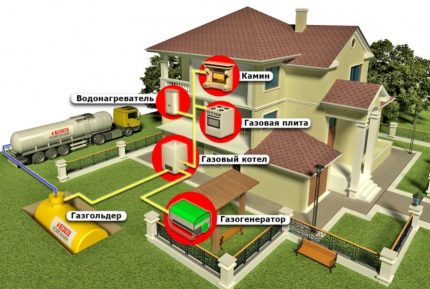
If you decide to independently collect all the necessary documents, you need to start by writing an application to the GDS to issue technical specifications for autonomous gasification.
TU are issued free of charge. Then you will need to make an advance so that the design work begins. The on-site specialist will evaluate the conditions and give a conclusion on the basis of which the technical specifications will be drawn up.
After receiving them, you will have to submit a new application to the design organization, on the basis of which and the received technical conditions the project will be developed. Next, you need to coordinate it in the supervisory authorities - environmental, fire, architectural, electricity, as well as in the gas supply service.
A permit for autonomous gasification is issued at Rostekhnadzor after registration of all documents there.
After will remain choose gas holder, buy pipes and accessories, ensure compliance with all the requirements set forth in TU. The installation price is directly affected by the volume of tanks and their number, a list of ongoing work. Depending on how much a good gas tank costs, it will pay off in 2-3 years.
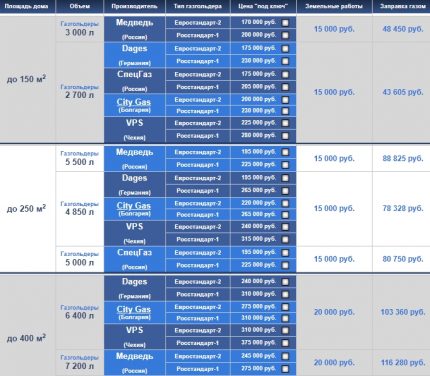
The most convenient season for carrying out work on autonomous gasification is the summer period. Usually the owner of a country house completely relies on the contractor to comply with the standards and the technical side of the process.
Even taking into account the fact that the owners of gas tanks are of little interest to GosNadzor, on the part of the contractor, all regulatory requirements and the rules for using tanks for LPG must be met.
Regulatory requirements for autonomous gasification
Poor installation can have unpredictable consequences, so it is desirable for the customer to monitor the progress of work. You need to understand the essence of the issue at the design stage. The main thing is to choose the right capacity in accordance with the area of the house. The volume of the tank for a private house ranges from 2700-10 000 liters.
Regulatory compliance is important distance from gas tank to home and other objects. The indicator depends on the volume of the tank. So, the minimum distance between the gas tank is 10 cubic meters. m and home - 10 m.
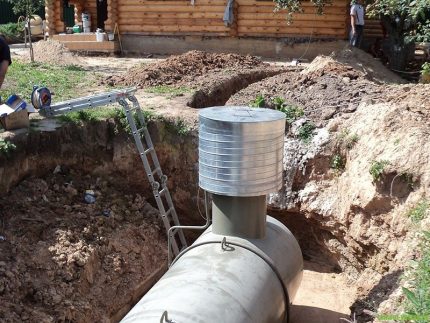
There are several basic regulatory documents related to the operation of gas tanks.
Although the requirements set forth in many of them apply to entrepreneurs and enterprises, regulatory authorities can apply them to individuals:
- In the appendices to the Federal Law No. 116, the gas holder is called a dangerous object. In this regard, the safety rules set forth in this law are applicable to such a tank.
- The code of rules 62.13330 relating to design, material for the gas pipeline, installation, quality of the gas mixture, corrosion protection of LPG facilities.
- There are several requirements for tanks for LPG regarding installation, testing in the codes of rules SP42.101 and SP42.103 of 2003, as well as SP.42.102 of 2004.
In order not to be liable for the consequences of the unprofessional installation of the gas tank, you need to conclude a contract with the company for the provision of services, which stipulate the warranty period for the object, in addition, there must be a project.
What requests should the tank meet?
A good gas tank must meet the requirements for the thickness of the metal, the quality of the anti-corrosion coating, the waterproofing of the body, safety and control valves. It will be equipped with reliable supports, eliminating the possibility of deformation processes of the tank bottom.
A prerequisite for an underground tank is the presence of a high neck.
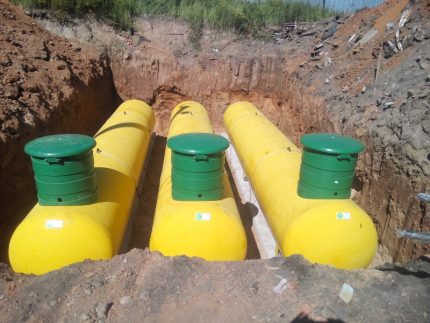
Based on the requirements of GOST, gas holders are made of sheet steel with a minimum thickness of 5.5 mm. Outside and inside the container has a protective coating.
On our site there is a series of articles on the choice of a gas tank for a private house and cottages. We advise you to familiarize yourself with:
- Gas holder for a summer residence: mini options for arranging summer cottages
- Mobile gas tank: purpose, design and installation features, placement requirements
- Gas tank Antonio Merloni (Antonio Merloni): lineup and equipment selection criteria
Nuances of installing a gas tank
In the CIS, gas holders are not as popular as in Europe. The rules for their installation are somewhat different. Whereas in European countries ground tanks are mainly used, in the CIS this option is not always acceptable. Here are more stringent requirements for the distance from the gas tank to various objects.
If they are carried out, in most standard sites there is simply no place for a ground tank, and in Europe they are even installed close to home.
In Europe, gas tanks are charged with pure propane, and in our country a mixture of propane and butane in a ratio of 1: 1 or 7: 3. In order for the LPG mixture to work, it is necessary that evaporation takes place, and at low temperatures this is impossible. In order not to be left without heat in winter, the tank must be equipped with a special installation for evaporation.
The cost of the equipment itself and its installation depends on the model of the tank, the volume of earthwork, and additional equipment. Questions about how much domestic and imported gas tanks will cost should be clarified in advance.
Note that prices do not vary much. Tanks produced by our manufacturers, unlike European products, as a rule, have a high neck.
A design without it is cheaper, but then the position of the site with the reinforcement will not be so convenient. Location on a hill allows you to protect it from moisture, especially during spring floods. If water enters the gearbox, the gas supply will stop.

Recently, gas holders without a neck have appeared. Instead of it, a number of high tubes closed by a metal casing are included in the design. This solution allowed to reduce the cost of the product and place the fittings at a safe height.
Structurally, the gas holder is designed to exclude both gas leaks and its ignition. Its monolithic structure is well resistant to pressure from the inside and various influences from the outside.

In addition to valves, the tank is equipped with safety valves designed to relieve excess pressure, ball valves, which regulate the fuel flow.
Some firms offer to buy reconditioned tanks at a price significantly lower than new ones. Do not be tempted by cheapness, the consequences of such savings can be the most unpredictable.
When installing the tank there are several nuances, the implementation of which must be monitored during its installation. Everything that will be hidden in the ground must be reliably protected from corrosion. In this case, ordinary fasteners are not suitable; they are made of stainless steel or provide corrosion protection.
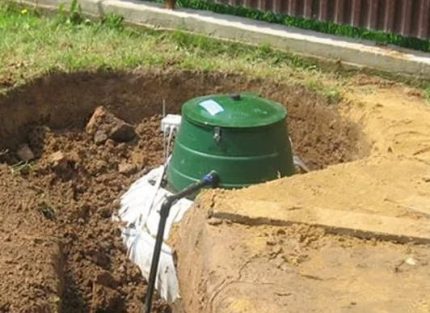
Often, cathodic protection contractors consider an additional service. In fact, without this option, a metal tank will collapse much faster than the service life allocated for it due to the influence of stray currents, salts and water.
When concluding a contract, it is imperative to insist that it includes a clause on the installation of electrochemical protection.
You should be aware that such protection is of two types - active and protective. The first of them is used together with Russian-made tanks made of 09G2S steel. This material is poorly resistant to rust.
To increase the service life of the capacitor, a 0.75 kW cathodic protection station is installed, consuming electricity. For this reason, this method of protection is expensive.
Import gas holders are made from higher quality material. They are protected from corrosion by the tread anode-cathode system. It is an aluminum element with electronegative potential, connected by wire to an underground gas tank.
The consequences of negative influences affect the tread - it is oxidized, and the surface of the metal container is restored.
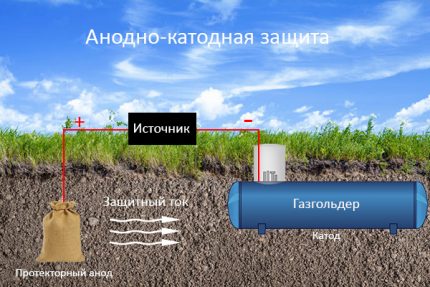
On European-made gas holders with a complete epoxy coating, protectors change on average after 5 years. The steel from which the Polish tanks Avtonomgaz is made practically does not corrode. The protection here is updated with a frequency of 15 years.
On domestic tanks with a bituminous coating, and on imported ones with an epoxy coating not tested during installation, protectors are replaced annually. In this case, the protective anode is consumed very quickly, because due to the increased permeability of the coating, he has to actively restore the surface of the tank.
How to recognize low-quality installation
In order not to have to invest additional funds in the autonomous gasification system of your house due to poor-quality work performed by the contractor, you need to pay attention to several important points.
It happens that the contractor, when installing a domestic-made gas tank made of steel with weak anti-corrosion characteristics, establishes passive protection or is going to miss this moment altogether.
In this case, you need to be persistent and force him to install an active cathodic protection system, regardless of the coating material. The cost of the gas tank will increase, but its service life will increase.
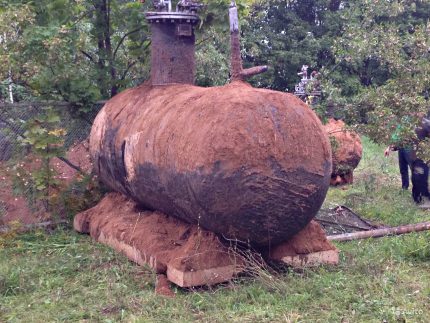
The surface of the tank with a bitumen coating layer of more than 2 mm during operation gives shrinkage and begins to crack. Passive protection in this case is powerless. Active electrochemical protection is needed.
The coating of a gas tank of domestic or foreign production is epoxy or bitumen before you place the tank in the pit, you must check it with a spark flaw detector. If the contractor has not done this, cathodic active protection is required.
The customer should also check the quality of the container fasteners to the plate. According to the rules, it must be fastened with stainless steel anchor pins for special paws.
If there are no supports in the form of paws, ballasting slings are used, with which the tank is attached to a plate having a rubber gasket. The use of these slings must be approved by Rostekhnadzor.
It is not allowed to install the tank on a hollow slab, because of this it can float along with the base. It is necessary to make sure that a condensate collector is installed, otherwise the liquid will form ice plugs in the pipeline during freezing and interfere with the gas movement.
The gas pipeline must be laid below the freezing level of the soil layers. Its installation should be carried out in such a way that a slope is formed in relation to the condensate collection tank.

The gearbox must be mounted on the tank itself. For gas pipelines of both medium and high pressure, only steel pipes with high-quality polymer insulation are used.
For the construction of a low pressure gas pipeline, PE 100 polyethylene pipes are more suitable than others. It must not be allowed for the gearbox or the filling valve to be set below the zero mark.
A compensator must be present on the basement input, otherwise, as a result of the shrinkage of the house, the input may be destroyed. The base entry itself must necessarily be all-welded and with a crane made of steel.
Additional information on the technology of installing a gas tank in a private area is provided in this article.
Conclusions and useful video on the topic
What is a gas holder and its design:
Advantages of the gas tank from the point of view of the owner of the site:
So that the price of installation and connection of a gas holder for a country house does not turn out to be unduly burdensome, and the costs pay off in a short time, it is necessary that the work is performed by experienced specialists - design engineers, welders and installers who have passed the relevant certification.
Of great importance is the choice of a gas tank of optimal volume, which will allow you to refuel it not too often. A professionally selected and installed tank will last a long time and will not cause much trouble.
Is there anything to supplement, or have questions about arranging an autonomous gasification of the house? You can leave comments on the publication, participate in discussions and share your own experience in choosing and installing a gas tank. The contact form is located in the lower block.

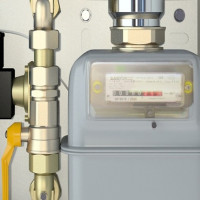 Gas consumption from the gas tank for heating: how to calculate + tips to minimize
Gas consumption from the gas tank for heating: how to calculate + tips to minimize 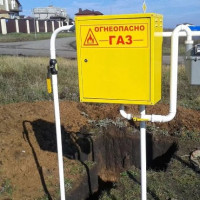 Which is cheaper and better - a gas tank or main gas? Comparative review
Which is cheaper and better - a gas tank or main gas? Comparative review 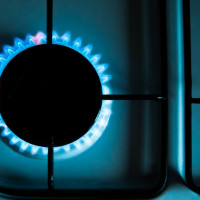 The rate of gas consumption per 1 person per month in a house without a meter: the principle of calculating gas costs
The rate of gas consumption per 1 person per month in a house without a meter: the principle of calculating gas costs  How long is the gas cylinder enough: gas flow calculation for typical gas cylinders
How long is the gas cylinder enough: gas flow calculation for typical gas cylinders 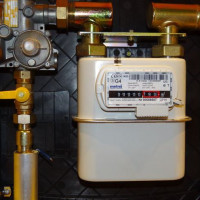 Standards for the distance from the gas meter to other devices: features of the arrangement of gas flow meters
Standards for the distance from the gas meter to other devices: features of the arrangement of gas flow meters 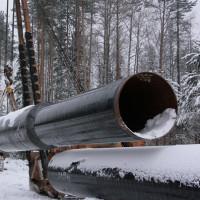 Calculation of the diameter of the gas pipeline: an example of calculation and features of the gas network
Calculation of the diameter of the gas pipeline: an example of calculation and features of the gas network  How much does it cost to connect gas to a private house: the price of organizing gas supply
How much does it cost to connect gas to a private house: the price of organizing gas supply  The best washing machines with dryer: model rating and customer tips
The best washing machines with dryer: model rating and customer tips  What is the color temperature of light and the nuances of choosing the temperature of the lamps to suit your needs
What is the color temperature of light and the nuances of choosing the temperature of the lamps to suit your needs  Replacement of a geyser in an apartment: replacement paperwork + basic norms and requirements
Replacement of a geyser in an apartment: replacement paperwork + basic norms and requirements
Gas in a private house is a very convenient thing, but, unlike the main gas pipeline, the gas tank has a decent number of minuses. And first of all, it is a big cost. The initial expenses for obtaining permits, the purchase of equipment and its installation are very decent. Plus refueling 2 times a year, plus service. In general, I personally abandoned the idea of installing a gas tank, especially since within 5 years they promise to extend a gas pipeline to us.
Well, yes, and you’ll be assigned to a certain company that will service and refuel the gas tank. Naturally, according to their tariffs with a margin, how much conscience is enough.
The gas bites today, anyway. The connection price eats up all subsequent “cheapness” ... Even in my case, when I mount everything with my own hands, and the gas holder is not a very cheap thing, since the gas itself has risen in price.
The use of electricity turned out to be cheaper: a boiler, a microwave, an electric kettle ... + energy-saving technologies. Although the use of gas (gas holder) left as an auxiliary system. But I have already developed a hydrogen system, and proceed to installation. It turns out many times cheaper.